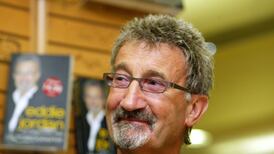Earl Gill, who has died aged 81, was one of Ireland’s most influential and accomplished professional musicians for over 60 years, both in terms of his technical excellence and his mentoring of a whole generation of younger musicians.
The resident band leader at the Shelbourne Hotel for over 40 years, he was also one of the last of the remaining great showband leaders of the 1960s and 1970s, when his Earl Gill and the Hoedowners, featuring Seán Dunphy and Amy Hayden as vocalists, was rarely out of the Irish charts.
Jazz musician Nigel Mooney, who played with Gill in the Shelbourne from 1994-1997, summed up his achievement this week to The Irish Times thus: "Earl was the godfather to whom everyone looked up; everyone wanted to play with him, everyone respected him."
Self-taught
This was all the more remarkable for someone self-taught, and whose early ambitions to be a pianist were thwarted by an accident, aged just 12, when he lost two fingers of his left hand. Switching to the trumpet, by 15 he had left school to play professionally, six nights weekly at the Olympia Theatre.
Gay Byrne, on whose Late Late Show Gill played on many occasions, said this week, "Earl was a natural musician . . . he was held in the highest regard by other musicians because he was just so good."
Gill made his mark aged just 21 when he was asked to front for Stan Kenton at Dublin’s Theatre Royal, and then went to work with Noel Kearns at the Gresham Hotel, then Dublin’s leading dance venue. He moved to the Shelbourne as band leader in 1956, where he was to stay, with occasional breaks, until the late 1990s.
He was the choice again of the Theatre Royal to open Count Basie’s famous 1957 concert there.
In 1965, Gill left the Shelbourne to form the Earl Gill showband, later Earl Gill and the Hoedowners, (a good history of which is available at www. irish-showbands.com), having hits with Dunphy, including Wonderful World of My Dreams, The Lonely Woods of Upton, Pal of my Cradle Days, and Dunphy's 1967 Eurovision runner-up If I Could Choose, a version of which Gill played instrumentally in a solo single.
Dec Cluskey of The Bachelors, the Irish pop group which began making hit records in the 1960s, recalled: “No journey to school or work was complete without marvelling at the hundreds of posters on the walls and lamp posts for Earl Gill.
“He was the first superstar single name showband leader. He bridged the gap between the classy, brass-led, big band style and the brash, showy style of the thousands of showbands trekking up and down the roads of Ireland every night of the week.”
The Hoedowners' Eamonn Young, describing Gill's style, says that initially the young Gill modelled himself on the great American trumpeter of the 1930s, Harry James: "Earl emulated that pure, true, quality tone of James and one of Earl's favourite pieces was James' You Made Me Love You. When Earl played that piece, close your eyes and you would hear the great Harry James."
Ruffled feathers
But, added Young, Gill was not afraid to innovate, and ruffled feathers in the 1960s when he often played with a type of trumpet designed for Dizzy Gillespie with a bell (the horn opening) at a 45 degree angle to the mouthpiece.
Nigel Mooney recalls another great influence was Eddie Calvart, remarking that "stylistically, Earl was influenced by the pre-be-boppers," the more traditional players of the pre-second World War era.
After the Hoedowners split up in 1973, Gill returned to the Shelbourne and to session work, occasional television work, and musical direction, the latter, most memorably, for Noel Pearson's 1985 production of HMS Pinafore at the Gaiety Theatre, when Pearson told the congregation at Gill's funeral Mass on Thursday, he "rescued the show", by striking up the interval music following actor Alan Devlin's infamous walk off the stage, allowing time for the understudy to be readied for taking over Devlin's part – the lead.
He continued to tour the country, in constant demand until illness forced his retirement in 2012.
Earl William Gill – his unconventional first name was chosen, he told the Irish Press in 1985, by his mother after she had seen it in an American movie credit – was born in Dublin's East Wall in 1932, one of two children of William Gill, pianist at the Queen's Theatre, and his wife Mary (née Hunter). He was educated locally.
He was married, firstly, to Deirdre Kenny, with whom he had sons Derek and Earl jnr and daughter Susan. Deirdre and his sister Muriel predeceased him, and he is survived by the children of his first marriage and his widow, choreographer Mavis Ascott, their son, Robin, and by grandchildren.









